This is a how to article that discusses how to set up a community fish tank, how to set up a fish tank for the first time and some of the things that new fish keepers may have wished they had known first.

How To Set Up Your New Aquarium-Schooling Community Fish Tank:
by davenmidtown
This article discusses setting up a community fish tank for the first time.
Introduction and Scope: Community Fish:
This article focuses on community fish and their environment:
This is an article that is aimed at beginning and intermediate fish keepers who may want to add schooling fish to their new aquarium or who may want to set up an aquarium just for schooling fish. The FOCUS of this article will be on the fish. A link to setting up your fish tank is here: Setting Up A New Freshwater Aquarium
Schooling fish or sometimes written as shoaling fish are fish of the same species that swim in groups. As such it is important that they stay in groups so always by schooling fish in groups of 6 or more...I will explain this later.
In the following paragraphs I will provide a list of fish that are compatible with each other and will separate them by aquarium size...Small, Medium, and Large tanks. I will provide links to other articles that will help aquarium keepers set up and understand the basic care of keeping fish.
Community Fish Tank
how to set up a community fish tank
What Are Schooling Fish:
Difference of Schooling Fish and other fish:
Schooling fish are fish that swim in tightly formed but uniform groups. There are several benefits of swimming in schools that help fish that school to survive and thrive in their environments. The first is that there is less change of becoming prey when fish swim in groups. The uniform movement of their tails also help to propel the group as a whole which allows the school to swim faster. In the aquarium setting, schooling loses most of its tremendous benefits that it has in the wild. However, it is important that schooling fish be kept in groups of sufficient numbers.
One of the key differences of schooling fish and predators is their lack of defense with perhaps the exception of some schools of piranha which hunt in schools. Consider the Great White Shark and the Lone Tetra... the advantage of the shark is obvious. Through natural selection schooling fish have developed a dependency on each other that exists even in the aquarium setting. It is the comfort of others that allows these fish to thrive. It is important that they be kept in sufficient number of their own species so that they thrive. small groups of schooling fish are nervous and do not swim in a natural manner. The beauty of schooling fish is their pattern of swimming, uniform movement and sudden turns. This is what fish keepers want to create in a schooling aquarium. It is all fine and dandy to watch at lone Neon Tetra twitch nervously but quite another to see a group of 20 Neon Tetra cruise about the tank.
Cichlids
African Cichlids are beautiful but highly aggressive.
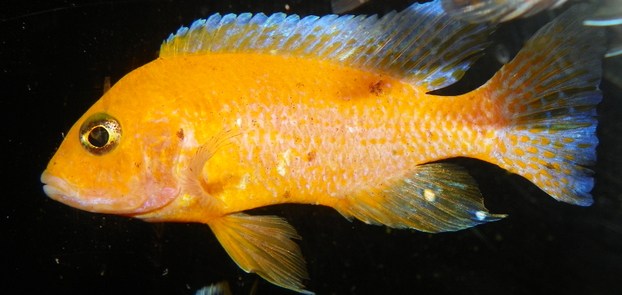 African cichlid David Stillwell |
Why Numbers of Fish Are Important:
Schooling Fish Need To Be Kept In Groups:
Everyone wants the brightly colored fish such as the Cardinal Tetra or the Neon Tetra...but if you can not afford to buy six or more, then don't buy any. Save your money until you can buy a small school. I say this because buying less then six is only going to cause the fish to be stressed and then die off one by one. They need to be kept in schools and that means great numbers as opposed to one, two or three fish.
An ideal school size is about 18 fish, but that is not always possible in smaller tanks. This brings me to an important topic. Smaller tanks and water flow... Use undergravel filters with smaller tanks and especially with smaller fish. The reasons not to use piggy back filters, etc, is water that they can cause too much water current or water movement. Small fish do not have large amounts of energy to spend fighting current. They tire out quickly and then are sucked up into your filter. An undergravel filter will do all of the filtration that any other type of filter will do. I will discuss this in great detail under the Care section of this article.
Blood Parrot Cichlids
South American Cichlids are beautiful but they can be very aggressive.
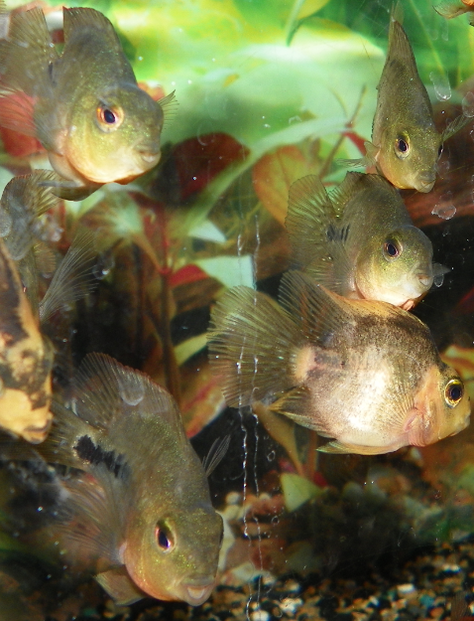 Parrot Cichlids David Stillwell |
Themes To Consider When Setting Up A Community Tank:
Building Living Art:
Themed fish tanks and aquariums are fun and the benefit of attempting something a little more complex is paid out in beauty and entertainment. If you are a fish keeper who is like me, then you enjoy the challenge of creating living art that inspires and please the eye while tempting the spirit to do more.
Being able to use rock, substrate, driftwood and plants to recreate nature is a challenge. It requires an eye for aesthetics and form while using concepts such as depth, shadow, and color to create breathtaking scenes that we never tire of looking at. That is the art of aquaria and the challenge and joy of fish keeping.
Themes are as follows:
Theme: The Community Tank:
How-To Create A Community Fish Tank as a Theme:
Substrate: medium sized gravel: Enough gravel to form a two inch layer evenly about the floor of the tank. Color is up to you though a natural setting shows off the color of the fish better.
Filter: Undergravel Filter: Use an air pump to provide filtration. A powerhead can also be used but only if it comes with a venturi value to reduce flow.
Decor: Consider using rocks, driftwood, and live plants. Artistically units should be placed in odd numbers... three rocks, five rocks, seven plants, etc.
Community Schooling Fish: Neon Tetra, Cardinal Tetra, Lemon Tetra, Diamond Tetra, Black Neon Tetra, Head Lamp Tail Light Tetra, Lamp eye Tetra, Harlequin Rasbora, Lamb Chop Rasbora, Green eye Rasbora, Black Skirt Tetra, Bleeding Heart Tetra, Red Fin Tetra, Emperor Tetra, Pencil fish, Danios, and Hatchet fish all make great selections for Community Schooling Fish Tanks:
Themes are awesome
Sponge Bob Square Pants
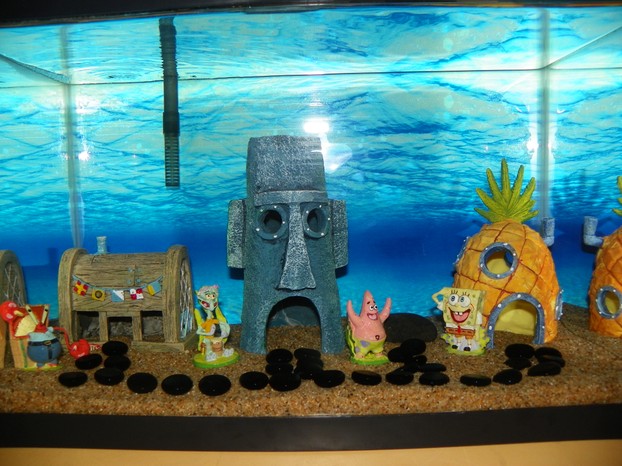 Sponge Bob Theme David Stillwell |
Care Of Community Fish:
How To Care For A Community Fish Tank:
Most fish need to be fed a minimum of twice per day. This is even truer of small active fish which burn calories faster then slow and lethargic fish. Fish should be fed twice or even three times per day, but feed them only what they will eat in three minutes of time. While feeding is important it is equally important not to over feed your fish.
Water Changes: Water in tropical fish tanks should be changed weekly with a range of 10-15 percent of the water being change WHILE the gravel is being cleaned. To make this an efficient process use a gravel vacuum. I prefer the ones that connect directly to the sink but the hand held/bucket method gravel vacuums work just find too. I also recommend checking your water chemistry at least once per week, because it takes a lot of effort and work to correct water chemistry that has begun to show signs of ammonia. Smaller fish are more susceptible to lower doses of water toxicity such as ammonia or nitrite.
Theme: Semi Aggressive Schooling Fish:
How To Choose Semi-Aggressive Schooling Fish:
The schooling fish that are semi aggressive are usually chasers and nippers. A community of semi aggressive fish are active and entertaining but should be kept with species of similar characteristics such as size. Overly aggressive fish should be removed to their own tank as the beauty of watching schooling fish is the unique social structures that they form.
The Semi-Aggressive Schooling fish are typically medium in size 3-6 inches in length. As such, they need a good sized tank to show off in, and that means, 55, 75, 90 gallon tanks work best.
Semi-Aggressive Fish Tank Set Up:
Fish Choices For Semi-Aggressive Fish Tanks:
Tank size: 55-90 gallons as these fish can grow 4-8 inches. The nice cube shaped tanks offered by oceanic make really nice semi aggressive tanks.
For almost every kind of tank my filtration answer is an undergavel filter. In the semi aggressive tank I would actually recommend a canister filter if you decide to use sand as a substrate, otherwise I say use an undergravel filter.
Substrate: Sand or medium sized gravel. These kinds of tanks make great planted fish tanks which is why I suggest sand as a substrate. I have also recommend a Geophagus Surinamensis which is a digger... so no live pants with him. That is an optional fish choice. I try to give suggestions but leave the actual decisions up to you.
Decore: Driftwood, plants (plastic, silk or live), rocks, interesting decorations. Leave lots of swimming space so that you can view the schools of fish. Too much stuff in the tank and you lose the effect of the school.
Schooling Fish Choice: Panda Barb, Roseline Shark sometimes called a Roseline Rasbora, Odessa Barb, Congo Tetra, Rainbowfish (Not dwarf varieties.) Rosy Barb, Giant Danio, Bosmoni Rainbow, Bala Shark, Siamese Algae eaters (2-5 fish.) Most of these fish will stay in the middle area of the tank. Feel free to add fish to the bottom layer as suggested below.
Bottom Layer/Feeders: Skunk Loach (5-8 of them), Gold Nugget Plecostomus, Red High Fin Plecostomus, Emperor Plecostomus, 6-9 Cory Catfish, Yoyo Loach. You could even add spiny eels such as the porthole eel, tire track eel, etc. The fire eels can get way too big. I have seen them the size of an adult males arm. Dwarf Cichlids such as the Ram, Apistogramma, cockatoo cichlids, Buffalo Head Cichlid, Kribensis I would keep one species of dwarf cichlids and not several. Your tank will be happier if it only has one group of dwarf cichlids to deal with.
Live Plant Choices: Anubia, Vallisneria, Amazon Sword, Big Bear Sword, Parrot Feather, Java Fern, Java Moss, Chain swords, and Penny wart.
Fish NOT recommended: No catfish other then the cory catfish. Catfish have large mouths and will eat whatever will fit in their mouth. No Cichlids other than the South American Dwarf Cichlids. No regular plecostomus or any plecostomus that is going to grow over 12 inches in length.
Red Devil Cichlid
Highly aggressive best kept alone
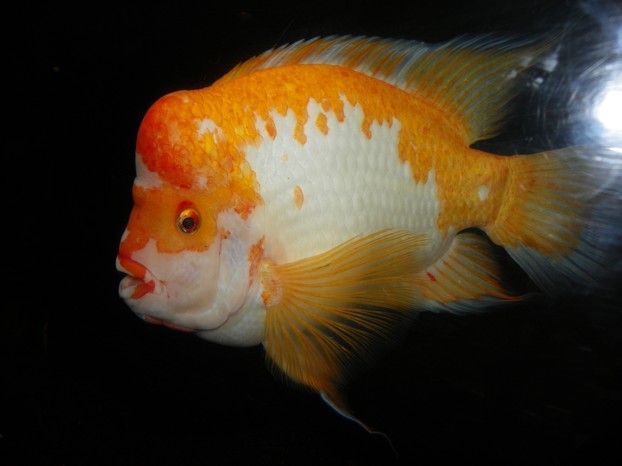 Red Devil Cichlid David Stillwell |
Theme: Rainbow Fish:
Introduction To Rainbow Fish:
Rainbow fish are a very large genus of fish from around the tropical world. Rainbow fish are schooling fish and really like to be kept in large numbers 8-12 or each species. Half males to half females if you want the males to show off their colors... and they are beautiful. They enjoy a medium planted tank with lots of swimming room. Live plants over plastic, with the same basic set up as the Semi-aggressive tank. Rainbow fish are somewhere between community and semi-aggressive but consider just keeping rainbow fish as they are really striking and quite beautiful to watch.
Species include: Bosemani Rainbow, Celebese Rainbow, Red Indian Rainbow, Turquoise Rainbow, the Neon Rainbow, Northern Rainbow, and the Madagascar Rainbow. There are other species you can explore but these I have see or raised and would recommend them based on their beauty and size. Awesome fish!
Questions:
I am Happy To Answer Questions if Readers Should Have Any.
I am available to answer your questions. If you would like to leave a comment or if you have a questions please post them in the comment section below. Thank you for reading.
You might also like
A Fast and Effortless Way to Clean your Fish TankAfter twenty years of caring for goldfish, I've just been so startled by an a...
All You Need to Know About Keeping Coolie LoachesHow to keep Coolie Loaches in your tropical fish tank. Learn how to care for ...
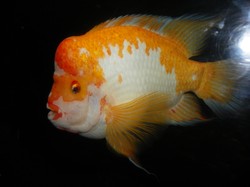


 Shmoo and the thing on the roof:on 11/12/2012
Shmoo and the thing on the roof:on 11/12/2012
 Motheron 11/03/2012
Motheron 11/03/2012
 A Murder of Crowon 11/02/2012
A Murder of Crowon 11/02/2012
 Face of Stoneon 10/29/2012
Face of Stoneon 10/29/2012
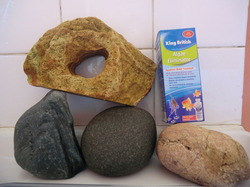
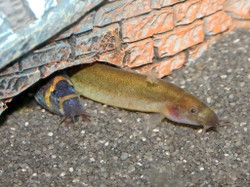
Comments
Thank you. I hope this article helps a lot of people enjoy their fish tanks!
This is an excellent introduction to setting up an aquarium. I'm not a beginner but can always use beginner information to remind me to take care of the basics.